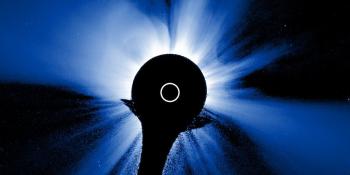Het archief bekijken van maandag 16 juni 2003
Activiteitenrapport
Bij elke genoemde zonnevlam in dit rapport werd een schaalfactor toegepast door het Space Weather Prediction Center (SWPC). Vanwege de SWPC-schaalfactor worden zonnevlammen 42% kleiner gerapporteerd dan voor de wetenschappelijke data. De schaalfactor werd verwijderd uit onze gearchiveerde zonnevlamdata om de werkelijke fysieke eenheden weer te geven.
Rapport van de zonne- en geofysische activiteit van 2003 Jun 16 2200 UTCOpgemaakt door de NOAA © SWPC en verwerkt door Poollicht.be
USAF/NOAA rapport van de zonneactiviteit en geofysische activiteit
SDF Nummer 167 gepubliceerd omstreeks 2200Z op 16 Jun 2003IA. Analyse van de actieve zonneregio's en zonneactiviteit van 15-2100Z tot 16-2100Z Solar activity was very high. New Region 386 (S07E71)
produced an X1/Sf flare at 15/2356 UTC with an associated Type II
(841 km/s) and Type IV radio sweep. SOHO/LACSO imagery indicates a
full halo CME, however the majority of the ejecta was off to the
east. Region 386 currently indicates a beta magnetic configuration
but its proximity to the east limb prevents a detailed analysis of
the magnetic complexity. Region 380 (S16W51) has slowed its rate of
decay and has developed a beta-gamma magnetic configuration. New
Region 386 was numbered today.
IB. Voorspelling zonneactiviteit
Solar activity is expected to be at
moderate to high levels. Region 386 is expected to produce M-class
and possibly X-class activity.
IIA. Samenvatting geofysische activiteit 15-2100Z tot 16-2100Z
The geomagnetic field was at unsettled to minor storm levels. The
source of the minor storm conditions may be associated with the
Boulder magnetometer scaling problem (see comment in VII). Solar
wind speed was in gradual decay from a peak near 600 km/s early in
the day to a minimum of 450 km/s by 1600UTC. Wind speed then
increased to 550 km/s by the end of the day.
IIB. Voorspelling geofysische activiteit
The geomagnetic field is
expected to be quiet to active with a chance of isolated minor storm
levels. Late on day one or early on day two, weak CME shock effects
are possible from the X1 event mentioned in IA. A coronal hole high
speed flow is expected late on day two and day three with isolated
minor storm levels possible.
III. Kans zonnevlammen van 17 Jun tot 19 Jun
| Klasse M | 50% | 50% | 50% |
| Klasse X | 20% | 20% | 20% |
| Proton | 30% | 20% | 20% |
| PCAF | green | ||
IV. Penticton 10.7 cm Flux
Geobserveerd 16 Jun 123 Voorspeld 17 Jun-19 Jun 125/125/120 90 dagen gemiddelde 16 Jun 124
V. Geomagnetische A index
Geobserveerd Afr/Ap 15 Jun 013/020 Geraamd Afr/Ap 16 Jun 014/023 Voorspeld Afr/Ap 17 Jun-19 Jun 012/015-020/030-020/030
VI. Kansen op geomagnetische activiteit van 17 Jun tot 19 Jun
| A. Gemiddelde breedtegraad | |||
|---|---|---|---|
| Actief | 25% | 30% | 35% |
| Kleine storm | 10% | 15% | 15% |
| Zware-ernstige stormcondities | 05% | 05% | 05% |
| B. Hoge breedtegraad | |||
|---|---|---|---|
| Actief | 30% | 40% | 40% |
| Kleine storm | 15% | 20% | 25% |
| Zware-ernstige stormcondities | 05% | 10% | 15% |
Alle tijden in UTC
<< Keer terug naar de dagelijkse overview pagina
Laatste nieuws
Laatste forumberichten
Noorderlicht kans mogelijkheid 6-14 dec 2025 14STEVE, een nog onbegrepen fenomeen 1Noorderlichtkans 11-12 november 2025 21Noorderlicht kans 18 juni 2025 3Noorderlicht 2 juni 2025 3
Meer forumberichtenSteun Poollicht.be!
Veel mensen komen naar Poollicht.be om de zonneactiviteit te volgen of om het poollicht te zien, maar met meer bezoekers komen er hogere kosten bij om de servers online te houden. Als je Poollicht.be leuk vindt en het project wilt steunen, kun je kiezen voor een abonnement op een advertentievrije website of een donatie overwegen. Met jouw hulp kunnen we Poollicht. be online houden!
Ruimteweer feitjes
| Laatste X-klasse uitbarsting | 08/12/2025 | X1.1 |
| Laatste M-klasse uitbarsting | 12/12/2025 | M1.1 |
| Laatste geomagnetische storm | 12/12/2025 | Kp5 (G1) |
| Zonnevlekkenloze dagen | |
|---|---|
| Laatste zonnevlekkenloze dag | 08/06/2022 |
| Maandelijks gemiddeld zonnevlekkengetal | |
|---|---|
| november 2025 | 91.8 -22.8 |
| december 2025 | 125.7 +33.9 |
| Afgelopen 30 dagen | 109.3 +18.1 |





